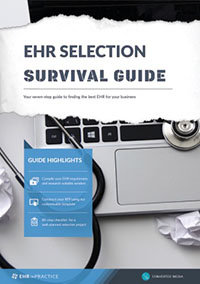EHR Change Management: The Key to Unlocking Practice Transformation
Change management is essential for successful integration of a new EHR system into your practice. It is the basic principle that underlies all phases of implementation and helps to achieve meaningful use and real practice transformation.
At its core, EHR change management allows staff to accept and embrace the new implementation, but change is not easy. Change can be especially difficult for a large practice setting with many healthcare departments that are set in their own ways. In addition, many healthcare practices have several leaders, overseeing different roles. It is essential that all leaders have a shared vision for the practice and for the new EHR system.
The First Step
The first step to bring about successful change, is to assign an EHR leader within the practice. This individual must be someone that is well respected and appreciated. This point person will likely be a physician, nurse or practice manager that others listen to. He or she should be someone that was part of the EHR selection process and fully supportive of the new system. The point person must know how to properly convey the exciting changes that will soon come. Their role will be to build excitement and acceptance around the new system.
[Change management] is the basic principle that underlies all phases of implementation and helps to achieve meaningful use and real practice transformation.
The EHR leader must hold a practice wide meeting to introduce the new system and provide the staff a timeline for EHR training and implementation. This will provide the staff ample time to adjust to the idea of change. In addition, it will allow them to visualize how the system will impact their own job. This introduction should encourage two way communication, so that staff members become involved in the EHR changement process.
Expect Resistance
It is important to expect resistance when introducing such a large change, but clear and open communication will improve buy-in. Reasons for resistance will include:
- Complacency: it has always been done this way
- Resistance to technology: some people are afraid of technology, don’t feel like learning something new, additional responsibility
- Overworked/overscheduled staff: they cannot keep up with their own job duties, let alone learn a new system
- Poor work morale: hearsay can lead to resentful staff, feeling as if the change is to increase the administrative bottom line
Therefore, it is important to clearly and accurately convey the benefit for each level of personnel. Administration needs to understand the return on the investment. These returns include improved efficiency of practice systems and processes, more streamlined billing and collections, as well as cost avoidance through compliance alerts and billing coding. Clinicians need to understand that they will be able to deliver improved patient care with less cumbersome billing and streamlined visit notes. Patients will have expanded access to their health information and there will be better communication between clinicians and patients. In addition, patient outcomes are more easily tracked and automated.
Keep communication open during EHR change management and you will achieve greater user buy-in. Clinical staff need to approach EHR implementation with a positive attitude for more successful training and utilization.
Free white paper

EHR Selection Survival Guide
The comprehensive guide to selecting the best EHR system for your medical practice.

Featured white papers
-

EHR Implementation Template
Get all the planning tools you need to make your EHR implementation a success
Download -

EHR implementation: 6 steps to success
Step-by-step information on how to implement EHR effectively
Download -

EHR Vendor Directory
Get the most up-to-date directory of EHR software vendors. Find the best software for your practice.
Download
Related articles
-

EHR Implementation Plan: Your 8-Step Checklist
Your comprehensive checklist for creating an EHR implementation plan.
-

A template for your EHR project implementation timeline
Determining your EHR project timeline will prove tricky, but having some expectations of time fra...
-

5 important areas of EHR training during implementation
Successful EHR implementation is not possible without crucial EHR training

